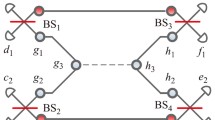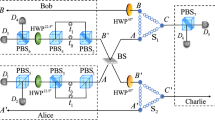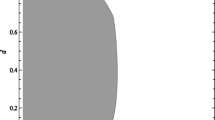Abstract
How to concentrate non-maximally entangled states for quantum communication is a fundamental problem in quantum information. In this paper, we will apply generalized measurements to entanglement concentration of known non-maximally entangled pure states in arbitrary dimensional system. How to design the generalized measurements for the unambiguous discrimination of linearly independent non-orthogonal states is crucial for the concentration of the known non-maximally entangled states. The result shows that, any known non-maximally entangled pure state (for arbitrary dimensional system) can be transformed to the maximally entangled state only by introducing a qubit as ancilla and a joint unitary transformation operation on one of the entangled particles and the ancilla. In addition, because the less entangled state of each fail round will be re-concentrated too, the entanglement waste during the concentration process will be greatly reduced.
Similar content being viewed by others
References
C. H. Bennett, H. J. Bernstein, S. Popescu, and B. Schumacher, Phys. Rev. A 53, 2046 (1996).
S. Bose, V. Vedral, and P. L. Knight, Phys. Rev. A 60, 194 (1999).
C. H. Bennett, G. Brassard, S. Popescu, et al., Phys. Rev. Lett. 76, 722 (1996).
M. Yang, W. Song, and Z. L. Cao, Phys. Rev. A 71, 034312 (2005).
M. Yang, A. Delgado, L. Roa, and C. Saavedra, Opt. Commun. 282, 1482 (2008).
Z. Zhao, J. W. Pan, and M. S. Zhan, Phys. Rev. A 64, 014301 (2001).
T. Yamamoto, M. Koashi, and N. Imoto, Phys. Rev. A 64, 012304 (2001).
L. L. Sun, H. F. Wang, S. Zhang, and K. H. Yeon, J. Opt. Soc. Am. B 29, 630 (2012).
Y. B. Sheng, L. Zhou, and S. M. Zhao, Phys. Rev. A 85, 042302 (2012).
Z. Zhao, T. Yang, Y. A. Chen, et al., Phys. Rev. Lett. 90, 207901 (2003).
T. Yamamoto, M. Koashi, Ş. K. Özdemir, and N. Imoto, Nature 421, 343 (2003).
Z. L. Cao and M. Yang, J. Phys. B 36, 4245 (2003).
M. Yang and Z. L. Cao, Physica A 337, 141 (2004).
M. Z. L. Cao, M. Yang, and G. C. Guo, Phys. Lett. A 308, 349 (2003).
H. F. Wang, L. L. Sun, S. Zhang, and K. H. Yeon, Quantum Inf. Process 11, 431 (2012).
N. Paunković, Y. Omar, S. Bose, and V. Vedral, Phys. Rev. Lett. 88, 187903 (2002).
R. Horodecki, P. Horodecki, M. Horodecki, and K. Horodecki, Rev. Mod. Phys. 81, 865 (2009).
M. Horodecki, P. Horodecki, and R. Horodecki, Phys. Rev. Lett. 80, 5239 (1998).
D. Kaszlikowski, P. Gnaciński, M. Zukowski, et al., Phys. Rev. Lett. 85, 4418 (2000).
H. Bechmann-Pasquinucci and W. Tittel, Phys. Rev. A 61, 062308 (2000).
N. J. Cerf, M. Bourennane, A. Karlsson, and N. Gisin, Phys. Rev. Lett. 88, 127902 (2002).
J. C. Howell, A. Lamas-Linares, and D. Bouwmeester, Phys. Rev. Lett. 88, 030401 (2002).
H. de Riedmatten, I. Marcikic, H. Zbinden, and N. Gisin, Quant. Inf. Comp. 2, 425 (2002).
A. Vaziri, G. Weihs, and A. Zeilinger, Phys. Rev. Lett. 89, 240401 (2002).
L. Neves, G. Lima, J. G. Aguirre-Gómez, et al., Phys. Rev. Lett. 94, 100501 (2005).
C. M. Yao, Y. J. Gu, L. Ye, and G. C. Guo, Chin. Phys. Lett. 19, 1242 (2002).
A. Vaziri, J. W. Pan, T. Jennewein, et al., Phys. Rev. Lett. 91, 227902 (2003).
A. Chefles, Phys. Lett. A 239, 339 (1998).
B. He and J. A. Bergou, Phys. Lett. A 356, 306 (2006).
C. H. Bennett, D. P. DiVincenzo, J. A. Smolin, and W. K. Wootters, Phys. Rev. A 54, 3824 (1996).
M. Horodecki, P. Horodecki, and R. Horodecki, Phys. Rev. Lett. 84, 2014 (2000).
S. Ryu, W. Cai, and A. Caro, Phys. Rev. A 77, 052312 (2008).
Author information
Authors and Affiliations
Corresponding author
Additional information
The article is published in the original.
Rights and permissions
About this article
Cite this article
Du, C.Q., Yang, M., Lu, Y. et al. Scheme for realizing entanglement concentration via generalized measurements. Jetp Lett. 96, 486–490 (2012). https://doi.org/10.1134/S0021364012190058
Received:
Accepted:
Published:
Issue Date:
DOI: https://doi.org/10.1134/S0021364012190058




